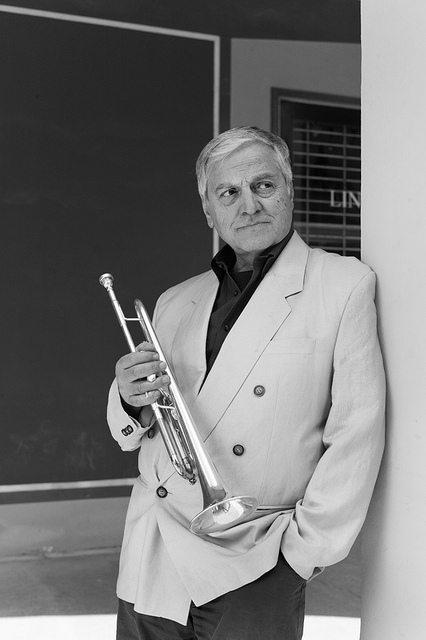Dusko Goykovich was born in Jajce, Bosnia in 1931. He studied at Belgrade’s Music Academy from 1948 to 1953. He was a member of several jazz and dixie groups as a young man, and later performed at parties at the capital’s embassies. He was a young, talented jazz musician who could also read music when he joined Radio Big Band of Belgrade at the age of 18. Five years later, Dusko was a well-respected soloist and a great big band player. Dusko moved to Germany, where he became an integral part the uprising German jazz scene. He made his debut record in 1956 as a member the Frankfurt All-Stars. After a brief stint with Max Greger’s big band in Munich, Dusko joined Kurt Edelhagen’s group, Europe’s top jazz orchestra, for four years. Edelhagen’s arrangers included Francy Boland and Claus Ogermann as well as Jerry van Rooyen, Rob Pronk, and Jerry van Rooyen. Dusko was the band’s top trumpet soloist and he also performed with Chet Baker and Stan Getz. He was no surprise to be invited to perform with the Newport International Youth Band during the Newport Jazz Festival in 1958. Albert Mangelsdorff and Ronnie Ross were also part of the Newport band, as was George Gruntz and G?bor Z?bo. After the Newport performance, Dusko’s trumpet was very well-received in Europe. The Berklee School of Music gave Dusko, then 29, a grant to study composition and arrangement in Boston. Herb Pomeroy would later become one of his teachers. Dusko was eager to write his own arrangements for his love, the big bands. However, he concentrated so much on his studies at Berklee that he turned down invitations from Stan Kenton, Count Basie and Benny Goodman. Dusko, now also flugelhorn, recorded while at Berklee with the Berklee School Quintet and Orchestra, which included fellow students like Gary Burton, Mike Gibbs and Sadao Watanabe as well as Mike Nock and Mike Nock. After completing his studies, Dusko was ready to return to Germany. However, Maynard Ferguson, a Canadian bandleader, called Dusko to offer him Rolf Ericson’s spot (who had just joined Ellington). Dusko agreed. Ferguson, a great trumpeter, invited Dusko to be his second trumpet soloist. He even used some of his big-band arrangements. After Ferguson’s band split up in 1964, Dusko joined Woody Herman for one year. His work with Herman was what made Dusko a world-renowned soloist and big band player. “Woody Herman encouraged me a lot,” Dusko recalls. “He not only accepted me big band charts (with one exception), but also recorded them all.” In the same year, Dusko and Sal Nistico left Herman’s group and returned to Europe to record their own music. Nathan Davis and Mal Waldron were part of his Swinging Macedonia (1966), which emphasized Dusko’s personal, Balkan-influenced style. Dusko, who was then part of the most prestigious international jazz musicians, also played with Miles Davis and Dizzy Gillespie. In 1966, he continued his big band career by joining the Clarke-Boland Big Band. This group included some of Europe’s most talented musicians, including Johnny Griffin, Idrees Sueman, Johnny Griffin and Jimmy Woode. Although the CBBB was the best jazz orchestra of the Sixties, it rarely played live for audiences. Dusko Goykovich started writing big band charts for all his compositions, as well as many standard tunes, after his time at Berklee. His arrangements have been performed with many European big bands including the Dutch Skymasters and NDR. Dusko quickly established his own rehearsal big band in Munich, where he settled down in 1968. It included Rolf Ericson and Palle Mikkelborg as well as Rudi Fuesers and Ack van Rooyen. This band was unable to organize a European free-lance orchestra due to difficulties and was only revived for a few performances in 1981/82. Dusko managed to re-found his orchestra in 1986, and it has been a fixture on the music scene ever since. He also made a highly-acclaimed international return to recording with the prize-winning CD “Soul Connection”, which featured Tommy Flanagan and Jimmy Heath as well as Eddie Gomez, Mickey Roker, and Mickey Roker. Soul Connection was followed up by “Bebop City”, (ENJ-9015 2), which featured the young alto sax master Abraham Burton, Kenny Barron, Ray Drummond, and Alvin Queen on drums. 1996 was the year Dusko fulfilled a long-held wish: recording his own big band performing his music, “Balkan Connection”, (ENJ-9320 22). 1997 was another milestone in his career with the release of “Balkan Blue”, a 2-CD set (ENJ-9320 22,). Disc 1 features a relaxed quintet featuring Gianni Basso, an Italian master saxophonist. Disc 2 is an extended work performed in the NDR Philharmonic’s jazz rhythm section with Dusko Goykovich playing solo. Palle Mikkleborg, who had previously arranged a similar piece for Miles Davis, composed his compositions. Balkan Blue is a powerful reminder of Miles Davis’s work with Gil Evans, a seminal recording in our time.
